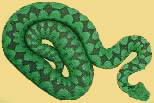 |
Aesculapian
Snake
Grass
Snake
Smooth
Snake
Nose-horned
Viper
Common European Viper
|
|
Adults are usually up to 65 cm, rarely 80 cm (even 90 cm), females are larger than males. Tail is 1/5-1/6 of total body length. Body is rather stout, has a flat (not upturned) snout (but van be sometimes mildly upturned). Most Adders have a clearly marked zig-zag stripe on back. This is usually without a very distinct paler central band (as in some other similar vipers). In rare cases the zig-zag is straight-edged, broken up, faint or even absent. Colouring varies: males are very contrasting (especially in spring), often being whitish or pale grey with intense black markings. Females are frequently brownish or reddish with dark brown markings. Other colour combinations exist and entirely black (melanistic) animals may be common (in polar areas up to 50%). Youn are often reddish,. Belly is grey, grey-brown or black, sometimes with white spots. Tail tip is yellow, orange or even red beneath.
Occurs on a wide variety of habitats, particularly in north of range. Here it is found on moors, heaths and dunes, and in bogs, open woods, field-edges, hedgerows, marshy meadows, and even salt marshes. In the south is more restricted and usually found in mountain areas, lowlands...
Mostly active by day, especially in north. Flattens body when basking. Melanistic individuals absorb heat better. Can travel 0.5-2 km from areas where they hibernate and (often) mate to feeding grounds and males may travel up to 200 m per day in breeding season.
Feeds on small mammals, birds, lizards and also frogs, young eat nestling rodents, small lizards and frogs. When one Adder kills a prey item, other Adders may come and try to take it and then they fight like males during breeding season.
Males wake up from hibernation
earlier and go to breeding areas first. During courtship they will attempt
to drive off rivals by hissing and lunging, after which combatants may
both rear up and press their forebodies against each other in an atempt to
press the oponent's head to the ground. The larger male usually wins.
The sexes press their bodies together in foreplay, before mating with
their tales raised, a proces that can last 2 hours. A male often
remains with a particular female for some time, copulating repeatedly, but
multiple paternity of clutches still sometimes occurs.
Gives birth to 3-18 young which mature in 3-4 years.
Can live 10 years in the wild.
Venom is quite potent, though bites
are not that dangerous as those of teh Asp Viper (Vipera aspis) and
Nose-horned Viper (Vipera ammodytes). Fangs of adult Adders are 4
mm long.
In humans bites cause sweling, pain, the surrounding tissue is destroyed,
in later stages can cause nausea and vomiting. For healthy adults a bite
is not life threatening, but it is still recommended to seek medical help.
Human fatalities are very rare.
The bosnian subspecies (Vipera b. bosniensis) has a stronger venom
that the normal subspecies (V. b. berus).
DID YOU KNOW:
* There are 2 subspecies in Croatia living in 3 separate populations on different habitats.
* Arround Vugrovec they are confirmed only in Markovo polje so far.
